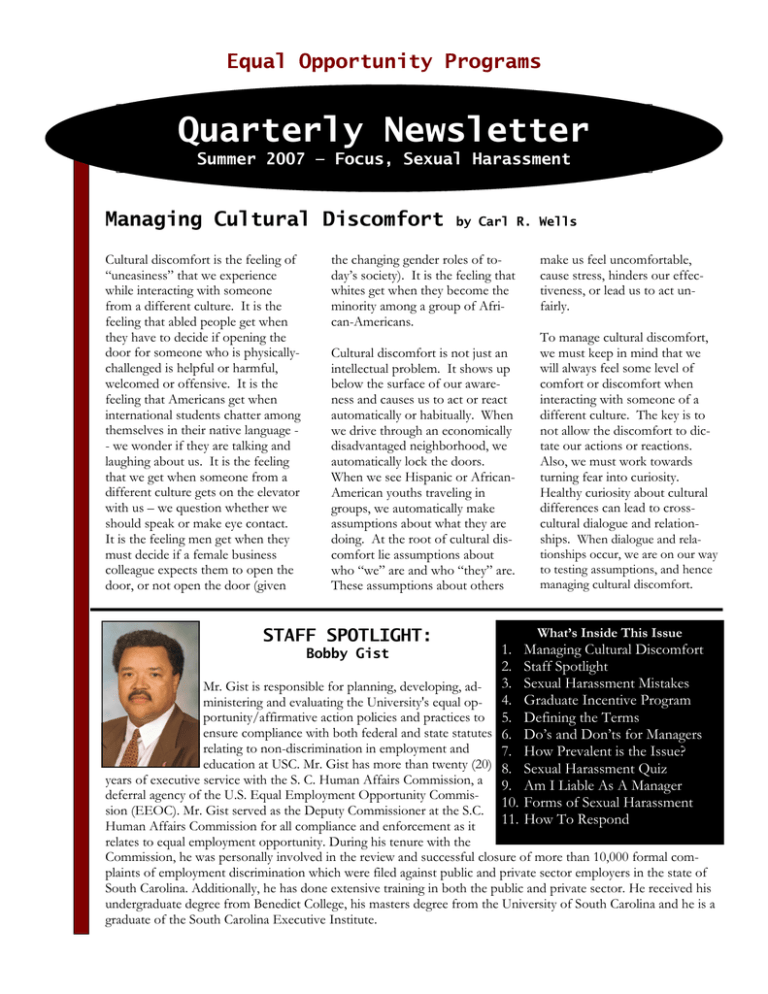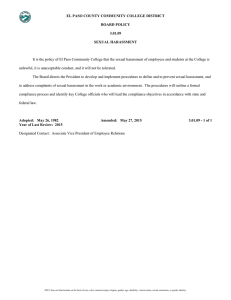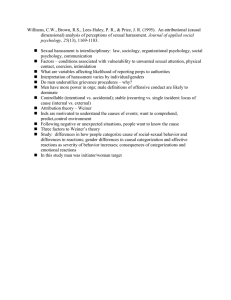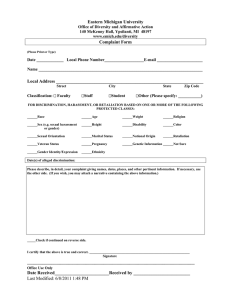
Equal Opportunity Programs
Quarterly Newsletter
Summer 2007 — Focus, Sexual Harassment
Managing Cultural Discomfort
Cultural discomfort is the feeling of
“uneasiness” that we experience
while interacting with someone
from a different culture. It is the
feeling that abled people get when
they have to decide if opening the
door for someone who is physicallychallenged is helpful or harmful,
welcomed or offensive. It is the
feeling that Americans get when
international students chatter among
themselves in their native language - we wonder if they are talking and
laughing about us. It is the feeling
that we get when someone from a
different culture gets on the elevator
with us – we question whether we
should speak or make eye contact.
It is the feeling men get when they
must decide if a female business
colleague expects them to open the
door, or not open the door (given
by Carl R. Wells
the changing gender roles of today’s society). It is the feeling that
whites get when they become the
minority among a group of African-Americans.
Cultural discomfort is not just an
intellectual problem. It shows up
below the surface of our awareness and causes us to act or react
automatically or habitually. When
we drive through an economically
disadvantaged neighborhood, we
automatically lock the doors.
When we see Hispanic or AfricanAmerican youths traveling in
groups, we automatically make
assumptions about what they are
doing. At the root of cultural discomfort lie assumptions about
who “we” are and who “they” are.
These assumptions about others
STAFF SPOTLIGHT:
1.
Bobby Gist
2.
Mr. Gist is responsible for planning, developing, ad- 3.
ministering and evaluating the University's equal op- 4.
portunity/affirmative action policies and practices to 5.
ensure compliance with both federal and state statutes 6.
relating to non-discrimination in employment and
7.
education at USC. Mr. Gist has more than twenty (20) 8.
years of executive service with the S. C. Human Affairs Commission, a 9.
deferral agency of the U.S. Equal Employment Opportunity Commis10.
sion (EEOC). Mr. Gist served as the Deputy Commissioner at the S.C.
11.
Human Affairs Commission for all compliance and enforcement as it
make us feel uncomfortable,
cause stress, hinders our effectiveness, or lead us to act unfairly.
To manage cultural discomfort,
we must keep in mind that we
will always feel some level of
comfort or discomfort when
interacting with someone of a
different culture. The key is to
not allow the discomfort to dictate our actions or reactions.
Also, we must work towards
turning fear into curiosity.
Healthy curiosity about cultural
differences can lead to crosscultural dialogue and relationships. When dialogue and relationships occur, we are on our way
to testing assumptions, and hence
managing cultural discomfort.
What’s Inside This Issue
Managing Cultural Discomfort
Staff Spotlight
Sexual Harassment Mistakes
Graduate Incentive Program
Defining the Terms
Do’s and Don’ts for Managers
How Prevalent is the Issue?
Sexual Harassment Quiz
Am I Liable As A Manager
Forms of Sexual Harassment
How To Respond
relates to equal employment opportunity. During his tenure with the
Commission, he was personally involved in the review and successful closure of more than 10,000 formal complaints of employment discrimination which were filed against public and private sector employers in the state of
South Carolina. Additionally, he has done extensive training in both the public and private sector. He received his
undergraduate degree from Benedict College, his masters degree from the University of South Carolina and he is a
graduate of the South Carolina Executive Institute.
Common Management Mistakes
When Addressing Sexual Harassment
Managers and directors often find that sexual harassment is a tough issue to deal with in the workplace; however, when properly handled
and addressed, this tough issue can become an opportunity for growth and development for everyone involved. Common managerial
sexual harassment mistakes are listed below:
1. Attempting to address the situation without the assistance of Legal, Human Resources, or EEO Professionals.
3. Minimizing the experience or feelings of the complainant.
4. Failing to model appropriate behavior for employees.
5. Failing to create an atmosphere that does not accept or nurture inappropriate behaviors.
6. Neglecting to take complaints seriously.
7. Failing to respond immediately.
8. Making decisions and drawing conclusions without first ascertaining the facts.
9. Failing to search for corroborating information.
11. Refusing to make credibility decisions.
10. Proceeding with actions without knowledge of internal policies and procedures.
12, Refusing to take appropriate disciplinary action.
13. Failing to inform complainants about the process and its outcomes.
14. Failing to protect complainants or witnesses against retaliation.
15. Failing to realize the alleged victim also has rights.
What Do Complainants Want?
Simply stated,
sensitive response. Most
complainants just want the
harassment to stop. The
rising number of complaints filed with state and
federal civil rights agencies
is the result of employers’
failure to take action.
the best
means of
dealing with
harassment is
to prevent it
from
happening.
Many complaints that are
filed with civil-rights agencies like the EEOC can be
prevented by a prompt and
It is interesting to note that
the majority of people who
have been harassed quit or
transfer out of the offensive
work environment. Simply
stated, the best means of
dealing with harassment is to
prevent it from happening.
Prevention begins with education and an attitude that
harassment, in any form,
will not be tolerated. When
incidents occur, however,
managers should respond
promptly and with sensitivity.
GRADUATE INCENTIVE SCHOLARSHIP
Funded by the South Carolina Commission on Higher Education, the Office of Access and Equity in partnership
with the University of South Carolina Graduate School offers the Graduate Incentive Scholarship. This scholarship
is to aid in the financial need of historically under-represented graduate students to attend the University of South
Carolina. The primary function of this fellowship is to recruit new historically under-represented graduate students
to the University of South Carolina. Priority is given to historically under-represented graduate students seeking degrees in academic majors with low representation. Retention of previous fellows is the secondary aspect of this
award. For additional information contact the Graduate School or Carl R. Wells @ (803) 777-9560.
Page 2
Quarterly Newsletter
Do’s and Don’ts For Managers
DON'TS
In addressing Allegations of Sexual Harassment
•
When interacting with the complainant or the alleged victim, don’t attempt to ease the tension by making jokes or comments that could be considered offensive. Act professionally at all times, especially
when dealing with allegations of sexual harassment.
•
Don’t respond to the situation if you are unsure of the appropriate actions to be taken or if you are not
familiar with internal policies. Contact Human Resources or the Office of Equal Opportunity Programs for assistance.
•
Don’t assume that your gut feelings are accurate. Get the facts.
•
Don’t grant some employees favors that others do not enjoy.
•
Don’t laugh at a joke one day and call it offensive the next.
•
Do take all complaints seriously, no matter what you believe to be true.
•
Do focus only on job tasks when talking to employees about performance.
•
Do learn about the issues of sexual harassment in the workplace by reading trade journals and newspapers and by familiarizing yourself with internal policies.
•
Do carefully document the incident by writing down the who, what, where, and when of each incident
and keep it on file.
•
Do take a training class on sexual harassment prevention.
DO’S
How Prevalent is the Issue?
Recent studies have indicated that approximately 4070% of women and 10-20% of men in the workplace have experienced some form of sexual harassment. The Equal Employment Opportunity Commission reviewed approximately 12,000 cases involving allegations of sexual harassment in 2006. The
number of cases continues to increase annually. A
growing trend is the filing of complaints by men.
The current percentage of claims brought by men
against female supervisors is 15.4%.
A telephone poll conducted on 782 employees revealed:
• 31% of the female employees claimed to have
been harassed at work.
• 7% of the male employees claimed to have been
harassed at work.
• 62% of employers took no action.
• 100% of women claimed the
Page 3
harasser was a man.
•
•
59% of men claimed the harasser was a woman.
41% of men claimed the harasser was another man.
Of the women who had been harassed:
•
•
•
•
43% were harassed by a supervisor.
27% were harassed by a senior employee.
19% were harassed by a co-worker at their level.
8% were harassed by a junior employee.
The current percentage of claims
brought by men against female
supervisors is 15.4%.
Permission to reprint granted by Diversified Risk Management, Inc. © 2007, PI 23294 All Rights Reserved.
Quarterly Newsletter
True or False:
Could The Action Constitute Sexual Harassment?
It is not easy to define sexual harassment and what constitutes an act of sexual harassment. In fact the
issue of harassing behavior is often very personal: what offends one person may not offend another. It is
therefore important for managers to understand what actions constitute sexual harassment. In response
to the question, “Could the action constitute sexual harassment?” circle either yes(Y) or no(N) for each
item below.
True
Y
False
N
2. You receive a complaint about a suggestive or sexist cartoon hanging over an employee’s desk.
Y
N
3. An employee complains about the fact that a fellow employee is ignoring him or her.
Y
N
4. Questionable or harassing behavior of a sexual nature by someone who is not employed by your organization.
Y
N
Y
N
Y
N
Y
N
Y
N
Y
N
Y
N
1. An employee files a complaint of sexual harassment but no physical act was involved.
5. The act of one employee merely staring at another employee.
6. Fellow employees engaged in the telling of dirty jokes or jokes with sexual innuendoes.
7. Uninvited touching of one employee by another.
8. An employee who was involved in an office romance receives a promotion.
9. You failed to promote an employee because he/she will not date you.
10. You invited a subordinate to go out on a date even though he/she has refused to go
out with you in the past.
Adapted from Sexual harassment In the Workplace: A Guide To Prevention, Juliana Lightle, Ph.D. and Elizabeth H. Doucet, Esq. Crisp Publications, Inc. Menlo Park, California
Answers are located on page 6!!!!
Am I Liable As A Manager?
Yes! Managers can be held liable given the following (depending on the circumstances):
• Harassment occurred and you knew, or should have known.
• Your organization failed to either institute or enforce a clearly stated policy which prohibits all forms of
harassment as defined by the law.
• You and your organization failed to educate your employees about the importance of nondiscriminatory
treatment of all employees.
• The procedures for making a formal harassment complaint are not made available to all employees.
Page 4
Quarterly Newsletter
The Recognized Forms of Sexual Harassment
Quid Pro Quo Harassment
Literally translated, quid pro quo means "this for that.” Quid pro quo harassment happens when
an employee is placed in a position wherein a choice must be made between submitting to sexual
advances or losing a tangible job benefit.
One of the essential qualifiers of quid pro quo harassment is the harasser's power to control the
employee's employment benefits. This kind of harassment most often occurs between supervisor
and employee.
There are several criteria that a claim of quid pro quo harassment must meet:
• The harassment was based on sex.
• The claimant was subjected to unwelcome sexual advances.
• A tangible economic benefit of the job was conditional on the claimant's submission to the
unwelcome sexual advances.
In quid pro quo cases, the harassment consists of unwelcome sexual advances, requests for sexual
favors, and other verbal or physical conduct of a sexual nature. The request may be implied or
actual. Again, the advances must be unwelcome, meaning that the person did not invite or solicit
the advances. Be mindful, however, that acquiescence or even voluntary participation in sexual
activity does not mean that the advances were not unwelcome. One factor to consider is whether
the person indicated that the advances were unwelcome notwithstanding acquiescence.
Hostile Work Environment Harassment
When the harassment is unwelcome conduct that is so severe or pervasive as to change the conditions of the claimant's employment and create an intimidating, hostile, or offensive work environment, then it is considered an act of hostile work environment.
•
•
•
•
•
•
Hostile work environment, however, can be distinguished from quid pro quo harassment.
Hostile work environment does not involve a tangible impact on an employee’s economic benefit.
Hostile work environment is not restricted to actions of a supervisor but includes the actions
of coworkers or third parties as well.
Hostile work environment can be constituted by actions other than sex or sexual advances.
Hostile work environment can exist even though the actions were not specifically directed at
the claimant but nonetheless impact his or her ability to perform the job for which he or she
was hired.
Hostile work environment usually involves a progression of several actions over a period of
time but can be constituted by a single offensive action.
In order for hostile work environment to be established or declared, three criteria must be met:
•
•
•
The act or behavior must be unwelcome.
The act or behavior has to be severe, pervasive, and perceived by the claimant as so
hostile or offensive as to alter his or her conditions of employment.
The act of behavior was such that a “reasonable” person would find it hostile or offensive.
Page 5
Quarterly Newsletter
How to Respond to Allegations of Sexual Harassment — Supervisor/Manager
•
•
•
•
•
•
•
•
•
•
•
•
Respond immediately by taking the complaint seriously.
Be aware that there are two (2) forms of sexual harassment: quid pro quo and hostile work environment.
Consult with the Office of Equal Opportunity Programs or the Office of Human Resources.
Familiarize yourself with the official internal policy. There are other forms of harassment based upon race,
religion, gender, age, etc.
Familiarize yourself with the alleged victim and the alleged offender. Determine if this is a first incident by
reviewing the personnel files of the complainant and the alleged victim, as well as your own personal notes.
Consult Equal Opportunity Programs or Human Resources. If either office deems it appropriate, interview
the victim, the harasser, and any witnesses.
Document every step to include dates, times, quotes, and any other information.
Never promise blanket confidentiality.
Communicate only on a “need to know” basis with victim, harasser, and persons with first-hand knowledge.
Working with Human Resources or Equal Opportunity Programs, establish some form of progressive discipline if warranted.
Follow-up with the victim, a response equally important is follow-through with the harasser.
Finally, remember that you serve as a model of appropriate behavior for your employees. Actions speak
louder than words.
Answers to What Actions Constitute Sexual Harassment?
Yes! Physical acts are only one form of sexual harassment. Jokes comments, leers and cartoons with sexual undertones may
also be considered sexual harassment.
Yes! The U.S. Supreme Court has said that acts that create a hostile or offensive work environment may constitute sexual
harassment. A cartoon with sexual undertones may be considered sexual harassment if it creates a hostile or offensive environment.
No! Under most circumstances this will not be considered sexual harassment. It might, however, be considered discrimination on the basis of sex depending on the circumstances.
Yes! Actions by clients, customers or other non-employees may constitute sexual harassment. The employer who knows of
the actions and takes no steps to stop them may be found legally liable.
Yes! Sexual harassment is a very personal matter. If “unwelcome,” starring or leering could be considered sexual harassment.
Yes! These are the type of actions that may create a hostile or offensive work environment.
Yes! Non-permitted or unwelcome acts are the essence of sexual harassment.
Yes! Acts of sexual harassment affect not only the direct participants, but others who may be denied employment opportunities or who work in the same area.
Yes! This is the quid pro quo situation.
Yes! This is true if the subordinate believes that rejection may result in adverse employment action.
Page 6
Quarterly Newsletter





